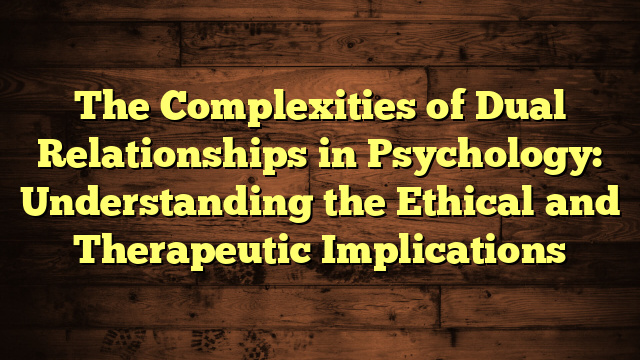The Complexities of Dual Relationships in Psychology: Understanding the Ethical and Therapeutic Implications
The Complexities of Dual Relationships in Psychology: Understanding the Ethical and Therapeutic Implications
Introduction
Dual relationships in psychology refer to situations where a therapist or psychologist has multiple roles or relationships with a client. These relationships can be complex and have ethical and therapeutic implications that need to be carefully considered. In this article, we will explore the complexities of dual relationships in psychology and discuss the importance of understanding the ethical and therapeutic implications.
Understanding Dual Relationships
Dual relationships can occur in various forms, such as when a therapist also becomes a friend, business partner, or romantic partner of a client. These relationships can develop naturally over time, especially in small communities or specialized fields where professionals and clients may have overlapping social circles or interests.
While dual relationships may seem harmless or even beneficial in some cases, they can create significant ethical and therapeutic challenges. The power dynamics inherent in the therapist-client relationship can be compromised when additional roles or relationships are introduced. This can lead to conflicts of interest, boundary violations, and potential harm to the client.
Ethical Implications
The American Psychological Association (APA) has established ethical guidelines to address the complexities of dual relationships and protect the well-being of clients. These guidelines emphasize the importance of maintaining clear boundaries, avoiding conflicts of interest, and prioritizing the best interests of the client.
One of the primary ethical concerns with dual relationships is the potential for exploitation or harm to the client. When a therapist has multiple roles or relationships with a client, it becomes challenging to separate personal interests from professional obligations. This can compromise the therapist’s objectivity, impair their judgment, and undermine the therapeutic process.
Another ethical consideration is the issue of informed consent. Clients have the right to be fully informed about the potential risks and benefits of therapy, including any dual relationships that may exist. Informed consent allows clients to make autonomous decisions about their treatment and ensures transparency and accountability on the part of the therapist.
Therapeutic Implications
Dual relationships can also have significant implications for the therapeutic process. When a therapist occupies multiple roles or relationships with a client, it can create confusion and blur the boundaries of the therapeutic relationship. This can hinder the client’s ability to trust and open up, which is essential for effective therapy.
Furthermore, dual relationships can introduce biases and conflicts of interest that compromise the therapist’s ability to provide unbiased and objective care. The therapist may find it challenging to separate their personal feelings or interests from their professional responsibilities, leading to potential harm to the client’s well-being.
Additionally, dual relationships can create a power imbalance that undermines the client’s autonomy and agency. Clients may feel pressured to comply with the therapist’s wishes or maintain the relationship out of fear of negative consequences. This can inhibit the client’s ability to assert their needs and preferences, ultimately hindering their progress in therapy.
Managing Dual Relationships
While dual relationships can be complex and challenging to navigate, there are strategies that therapists can employ to mitigate the ethical and therapeutic implications. The first step is to be aware of the potential for dual relationships and to actively monitor and evaluate any existing or emerging relationships with clients.
Therapists should also establish clear boundaries and communicate them openly with clients. This includes discussing the limitations of the therapeutic relationship and addressing any potential conflicts of interest that may arise. Transparency and open communication can help maintain trust and ensure that the client’s best interests are prioritized.
Consultation and supervision are essential tools for therapists dealing with dual relationships. Seeking guidance from colleagues or supervisors can provide an outside perspective and help therapists navigate complex ethical dilemmas. Supervision can also serve as a form of accountability and support, ensuring that therapists adhere to ethical guidelines and make informed decisions.
Conclusion
Dual relationships in psychology are complex and can have significant ethical and therapeutic implications. It is crucial for therapists to understand and navigate these complexities to ensure the well-being of their clients. By maintaining clear boundaries, prioritizing the best interests of the client, and seeking consultation and supervision when needed, therapists can effectively manage dual relationships and provide ethical and effective care.

